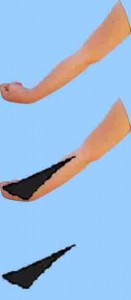The fifth of the 6 primary strokes is a stroke that slants upward toward the right, called 提 (tí) in Chinese.
To form this stroke, 2 joints of the arm must shift position. From the previous position of the arm extending diagonally downward from the body, rotate the bones of the forearm 180o rearward, such that the palm of the hand is no longer facing downward and inward but now faces upward and outward. The wrist now shifts its position from before, lifting the hand upward 45o, such that the hand now extends horizontally upward and outward toward the left. The fingers also change; closing the hand into a fist.
With the 3 strokes represented using the right hand, all 3 strokes used all 3 parts of the arm, the upper arm, the forearm, and the hand. With the 3 strokes represented using the left hand, all 3 strokes are different. Whereas the first stroke used all 3 parts of the arm, this second stroke uses only 2 parts of the arm. The tí is a shorter stroke, and only the hand and forearm are used to represent it. Notice that the emphasis is on the bottom of the stroke, at the beginning. In other words, there is greater pressure on the brush at the bottom of the stroke. The fist is represented by the greater pressure that is applied to the brush at the beginning of the stroke.
In the drawing of this stroke, Rule 1 and Rule 2 both apply, since this stroke is drawn both horizontally and vertically. In this case, Rule 2 takes precedence, the stroke extends from left to right. Rule 1 is therefore not honored, as the stroke is drawn from bottom to top. Because Rule 1 is not honored, this stroke is represented using the left arm.
The character that means eternal (yǒng) contains the tí stroke; it is the top stroke on the left side. Notice that this stroke is not horizontal, but rises slightly.

